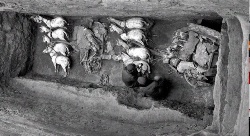
Construction and destruction
An official notice reads:
The Construction of the Terracotta Army Pits
The three underground pits are built in similar basic earth-and-wood structure, but vary in size and shape. The way to construct the pits is as follows: They were about five meters beneath the present ground level with the terracotta figures placed in corridors. The corridors, divided by earth-rammed partition walls, were paved with pottery bricks on which the figures were placed. The earth walls sustained wood roof that was composed of huge and strong rafters, the roof was covered by layers of fiber mats, earth fill and tilled earth. The sloping roadways were rammed by earth. All these were constructed to totally conceal the Terracotta Army.
… while the guidebook reads:
Unfortunately, soon after their completion, these pits were seriously damaged. Many terracotta figures were broken, a great number of bronze weapons were looted, the wooden structures in the pits were burned down, and their roofs caved in. According to archaeologists, the damage was caused by the rebel army led by Xiang Yu, Overlord of West Chu, when the army entered the Land Within the Passes at the end of the Qin Empire.
This is commonly quoted as taking place in 206 BC when Xiang Yu is said to have led a ‘peasant army’ seeking revenge on the Qin Empire after the death of Qin Shi Huang. After entering the Terracotta Warrior pits, flaming torches were used to set fire to the ‘huge and strong rafters’ that weakened and collapsed, bringing down the roof and compacted earth, so crushing the figures.